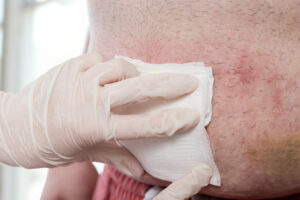In my last blog, I presented a case in which surgical debridement and Negative Pressure Wound Therapy were utilized in tandem. As noted, the patient’s wound decreased significantly in just 3 weeks. Therefore, I was very curious and decided to take a look at the rate by which the wound was healing. I was very much surprised.
The use of negative-pressure wound therapy (NPWT) has been shown to produce significant benefits in wound healing including surface tissue micro-deformation, decreased wound edema, and the removal of wound exudate. However, the effectiveness of NPWT on bioburden eradication is controversial. In fact, Weed et al (1) found bacterial colonization increased significantly with NPWT and remained in the range of 10(4)-10(6). Boone et al (2) found the bacterial burden continued to increase and broaden in a porcine wounds model. In another study, Yang et al (3) compared NPWT to negative pressure wound therapy installation (NPWTi) with a topical antimicrobial irrigation following sharp
debridement of which the latter yielded a 48% reduction in biofilm. However, after one week, there was no difference in the wound size between the two groups. Furthermore, an interesting study performed by Moog et al (4) indicated that NPWT did not improve bacterial bioburden in 77% of the cases regardless of the duration of negative pressure, however, NPWT coupled with surgical debridement and jet lavage decreased bacterial load in approximately 60% of the cases.
After researching the literature, I was quite surprised by the lack of studies focusing on the rate of wound closure. What I found more so were combinations with NPWT in the fight against biofilm and what methods were better suited to do so. The case I presented on my last BLOG consisted of a surgical debridement with NPWT. After one week, The wound reduced in size by 10.1% per the wound surface area before and after one week of NPWT. The literature has shown a decrease in bioburden in 60% of the cases in the Moog et al study, however, was it because it was surgically debrided, the NPWT, the reduction of the biofilm or a combination of all of the above? After one week with NPWT status post surgical debridement, I used the EZDebride Wound Instrument and the wound was sharply debrided. The NPWT was then applied. The following week the patient returned and the measurement of the wound was significantly smaller. The wound surface area reduced by 62.6%. The wound was much smaller and very superficial. I then sharply debrided the wound again with the EZDebride, reapplied the NPWT, and the patient was then seen one week following. After two weeks of just sharp debridement alone with NPWT x 6 applications, the wound’s surface area was reduced by 72.9% after one week since the last sharp debridement. In fact, the NPWT was then discontinued due to the very small size of the wound and topical triple antibiotic ointment was then used daily instead. Again, this was just with NPWT without installation therapy. And contrary to the what the literature suggested per biofilm/bioburden with NPWT alone as well as delayed wound healing as a result, the wound in question was healing at a surprisingly accelerated rate.
Could the EZDebride be the missing piece in the NPWT / Bioburden debacle? Could it be EZDebrides controlled depth debridement with minimal to no harm to the healthy tissue? Or could it be that EZDebride is capable to eradicate biofilm/bioburden effectively and with reproducible results? As you recall from the Journal of Wound Care, 2021, EZDebride was shown to reduce biofilm up to
75% with total eradication in 19% of study cases. Could EZDebride be the actual missing piece not only for NPWT, but with other therapies for effective, and rapid wound reduction?
We will continue our discussion next time and delineate further the advantages of the EZDebride Wound Instrument in Wound Bed Preparation. Please check back often and until next time, fair winds and following seas.
Cheers,
Dr. F. Derk



